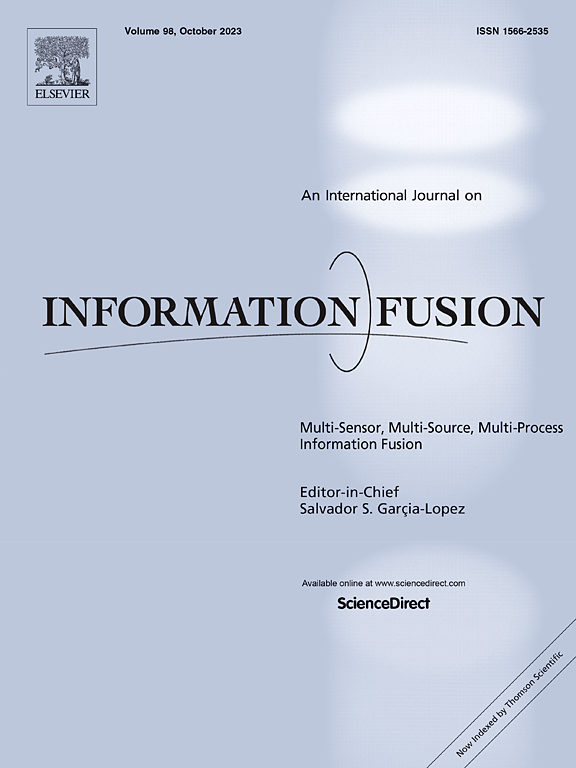无isp多光谱融合成像极低光增强摄影
IF 14.7
1区 计算机科学
Q1 COMPUTER SCIENCE, ARTIFICIAL INTELLIGENCE
引用次数: 0
摘要
在极低光照条件下实现高质量成像对于自动驾驶和夜间监控应用至关重要。传统的方法主要集中在退化RGB数据的后处理上,在输入信息有限和噪声干扰严重的极低光照情况下,这种方法很难有效地减轻噪声。在本研究中,提出了一种计算多光谱融合成像框架,通过将更宽光谱的光源信息编码到成像管道中来增强低光图像。设计了一个端到端的光谱融合网络(SPFNet),该网络由用于场景特征自动提取的编码器和用于信道融合的解码器组成,将光谱融合与图像去噪相结合。利用新颖的Multi_Conv模块,从多光谱原始数据中提取各种光谱特征,为噪声抑制提供多尺度交叉参考,从而促进高质量的图像融合。建立了一套试验光学系统,用于在每光谱照度低于0.01勒克斯的条件下捕获实时多光谱rgb数据集。实验结果证实,该方法明显优于传统的RGB成像技术,峰值信噪比(PSNR)平均提高7.87 dB以上,结构相似指数(SSIM)平均提高0.25。综合烧蚀和对比实验验证了该模型在细节重建和色彩保真度方面的最佳性能。该框架避开了繁琐的传统图像信号处理(ISP)流程和严格的实验限制,为便携式摄影、空间探索、遥感和深海探测等极低光成像应用提供了一种新颖可行的解决方案。本文章由计算机程序翻译,如有差异,请以英文原文为准。
ISP-free multi-spectrum fused imaging for extremely low-light enhanced photography
Achieving high-quality imaging under extremely low-light conditions is crucial for autonomous driving and night surveillance applications. Traditional approaches predominantly focus on the post-processing of degraded RGB data, which struggle to effectively mitigate noise in very low-light situations with limited input information and significant noise interference. In this study, a computational multi-spectral fusion imaging framework is proposed to enhance low-light images by encoding a broader spectrum of optical source information into the imaging pipeline. An end-to-end spectral fusion network (SPFNet), consisting of an encoder for the automatic extraction of scene features and decoder for channel fusion, is designed to integrate spectral fusion with image denoising. Utilizing the novel Multi_Conv module, a diverse range of spectral features are extracted from multi-spectral raw data, providing multi-scale cross-references for noise suppression, thereby facilitating high-quality image fusion. A pilot optical system was built to capture a real-scene multi-spectral-RGB dataset under illuminance conditions below 0.01 lx per spectrum. Experimental results confirm that the proposed method significantly outperforms traditional RGB imaging techniques, demonstrating an average improvement of over 7.87 dB in peak signal-to-noise ratio (PSNR) and 0.25 in structural similarity index (SSIM). Comprehensive ablation and contrast experiments were conducted to verify that the proposed model achieved the best performance in terms of detail reconstruction and color fidelity. Eschewing the need for a cumbersome traditional image signal processing (ISP) pipeline and strict experimental constraints, the proposed framework offers a novel and viable solution for extreme low-light imaging applications, including portable photography, space exploration, remote sensing, and deep-sea exploration.
求助全文
通过发布文献求助,成功后即可免费获取论文全文。
去求助
来源期刊

Information Fusion
工程技术-计算机:理论方法
CiteScore
33.20
自引率
4.30%
发文量
161
审稿时长
7.9 months
期刊介绍:
Information Fusion serves as a central platform for showcasing advancements in multi-sensor, multi-source, multi-process information fusion, fostering collaboration among diverse disciplines driving its progress. It is the leading outlet for sharing research and development in this field, focusing on architectures, algorithms, and applications. Papers dealing with fundamental theoretical analyses as well as those demonstrating their application to real-world problems will be welcome.
 求助内容:
求助内容: 应助结果提醒方式:
应助结果提醒方式:


